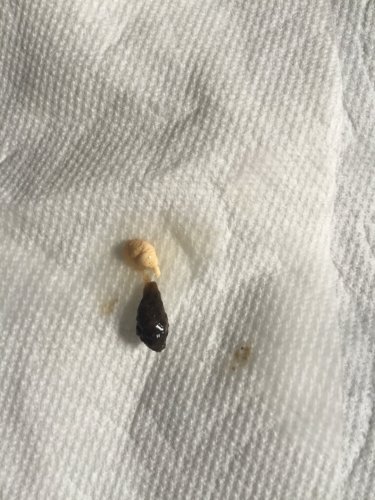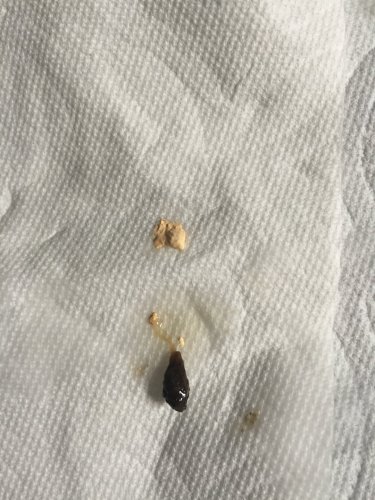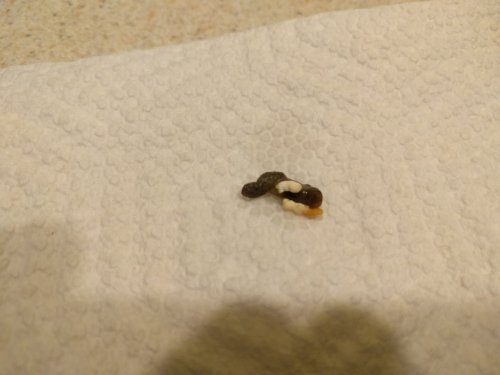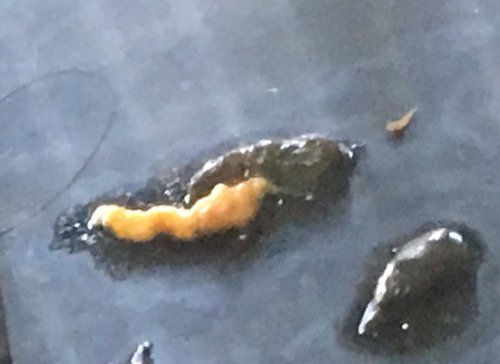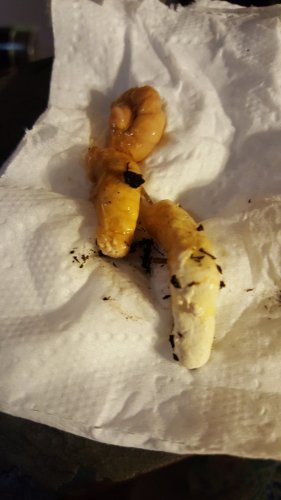Navigation
Install the app
How to install the app on iOS
Follow along with the video below to see how to install our site as a web app on your home screen.
Note: This feature may not be available in some browsers.
More options
You are using an out of date browser. It may not display this or other websites correctly.
You should upgrade or use an alternative browser.
You should upgrade or use an alternative browser.
Chameleon Poop 101
- Thread starter ferretinmyshoes
- Start date
melble68
Established Member
Yep absolutely appropriate, even though I giggle every time a reply comes thru on my email about this thread. IMHO your "baby poo" looks pretty typical and by the color of the urates its look adequately hydrated. Young chameleons will poo most of the time daily, as they get older, you will start to notice potentially the rate of doo doo to back off a few days or longer between. At that point you most likely notice a part of the urates to show a tad bit of orange (the part that's attached to the dark solids) and the tip will still be white. That's still pretty normal. When you start to see totally orange urates is the tell tale sign that you need to work on your chams hydration better. If you over do it with an over abundance of feeder worms, you may see the poo turn runny. If you notice a constant runny poo, set up an appointment w/ you vet to have him checked for parasites. I would recommend an appointment once a year anyways w/ you vet to have him checked out. Even though he may be currently parasite free, it is possible they can pick something up by the feeders we give them. We take our dogs and cats to the vet once a year, our chameleons should be not different. Being proactive on preventative care is a lot easy and more cost effective and safe, than reactive emergency care when something is actually wrong.I am not sure that it is appropriate to post this here but can someone help me look to my baby poo. Is it healthy or not....
Pascal_Sunny
Member
wow I love this thread! My Chams poo looks pretty normal, except its kind of a greenish...part of my gutloading is with lettuce...could that be what caused it? Also my Cham was just dewormed so idk if that would do anything to their poop.
kelly_girl199
Avid Member
Lately mine poops like this every 3 days or so. I see him drinking a lot of water though so I don't understand why it's still orange.One way we can monitor the health of our chameleons is monitoring their bowel movements (poop) for any problems. To be able to identify problems, first you need to be able to recognize what is or is not normal. There are two parts to a bowel movement in chameleons - a brown part (feces) and a white part (urates).
Feces
The brown part is feces from digested food like any animal will make. It should be brown or almost black, soft but firm, and have a well formed shape. Generally chameleon feces do not smell very much, if at all. If undigested insect parts are seen in the feces temperatures may not be appropriate or intestinal parasites may be altering digestion (see below). If many soft bodied worms are fed it may cause runny feces due to the extra hydration from the worms.

Image compliments of Trace
Urates
The white part of a bowel movement is called 'urates' and represents a more solidified version of urine. Reptiles have evolved to use water more efficiently so instead of urinating, they only excrete a concentrated solid waste and retain most of the fluid. This is especially useful in regions when water is not plentiful to prevent dehydration. Urates should be white, soft but firm and may have a chalky texture. A yellow tinge is okay but orange urates indicate that your chameleon may not be getting enough water. If your chameleon defecates infrequently the end of the urates may be more orange but the rest still looks white. The longer the urates sit in the body the more fluid is reabsorbed from them back into the body. A small amount of mostly clear fluid with the urates is true urine and indicates good hydration, but is not always present.

Image compliments of Trace
Frequency
How often your chameleon defecates depends on how often it eats, how much it eats and how long it basks. Basking is necessary for good metabolism and digestion of food, so low temperatures can delay digestion. Each chameleon can have a different pattern. Some will defecate every day (especially when younger) while other may be once every few days, once a week or once every two weeks. Most adult chameleons defecate once or twice a week generally.
Sperm Plugs
With the bowel movement of male chameleons you will usually see sperm plugs. These are a pair of white soft waxy deposits that dry out quickly.

Hemipenes
Sometimes you will see a red organ come out during a male's bowel movement for a short time and then to back into the body. That organ is a hemipene - the male reproductive organ. As long as it goes back in then it is nothing to worry about.
Parasites
Intestinal parasites can alter digestive processes as well as the bowel movement consistency or smell. Very soft, liquid or smelly feces could indicate an intestinal parasite problem. Only rarely with a large parasite burden will you be able to actually see the worm in the feces. For almost all intestinal parasite infections the only way to detect them is to look for the microscopic ova (eggs). The worms remain in the intestines and periodically shed ova that come out of the body in the feces where it can infect other animals if given the opportunity. Most parasites are not contagious to humans but always wash your hands well when you come into contact with fecal material.

Fecal exams
To detect parasites in feces collect some of the fresh feces (brown) portion with a tissue or paper towel and keep it in a sealed ziplock bag. If the feces are dried out wait for a fresher sample. You can store the fecal sample in a cool place for up to eight hours before delivering it to the vet. You can store it overnight in the refrigerator if you need to. Since excess heat or cold can kill the organisms in the feces, thus defeating your purpose for collecting it to begin with, don't freeze it or leave it in your car. Urates are not needed for fecal testing.
The primary fecal test the vet will do is a fecal flotation to check the feces for the presence of worm ova. A specific mineral solution is combined with the provided feces so that the ova separate from the feces and float to the top where they can collected and looked at under the microscope. Some intestinal parasites like protozoans are microscopic and can be seen in the feces themselves by performing a direct smear, where diluted feces are placed on a microscopic slide immediately for examination. Medication will be administered depending upon the type of organism found.
It is recommended to have fecal exams done on at least a yearly basis to detect parasites.
Some owners may want to do fecal exams themselves and can purchase the microscope and necessary supplies. If a parasite or ova is found the sample should still be taken to the vet for confirmation and to prescribe appropriate medications at the correct dosage. Dez has made a video on performing fecal floats for those interested. https://www.chameleonforums.com/how-do-fecal-float-video-111996/
Examples of bowel movements:

Normal bowel movement

Normal bowel movement and sperm plug on the rock next to it.

Normal feces and urates

Orange urates from inadequate hydration.

Large normal bowel movement

Mostly white urates and normal feces. This bowel movement was about a week after the previous one, so a little orange of the urates is okay.

Diarrhea due to a lot of hornworms in the diet which are very juicy.
zordtaz
Member
I guess since he didn't poo every day. Some of the water get absorb back to his body. Make sure you keep an eyes on his appertice and no sign of sunken eyes.Lately mine poops like this every 3 days or so. I see him drinking a lot of water though so I don't understand why it's still orange.
Hollywhyte
Avid Member
Is this to much orange

zordtaz
Member
It still look fine for meIs this to much orange View attachment 168869
MSMorgan
Avid Member
I've gotta share. Perfect place for this one. While feeding lucky this am, I opened the cage to see Lucky sitting in his usual spot. He was shifted to one side of the branch with a "leg cocked." I thought this was a weird pose, but Lucky's "a little off" anyhow. When I slid the cup off the side of the cage, Bombs away! he dropped it like a Luftwaffe bombardier. Next came the urate. It was so-so. Little tinge of yellow. I need to add another misting session, as the air is getting dryer in the house. Then, to my surprise, a sperm plug! I felt a little weird just sitting there watching him, but it was like a miniature train wreck. I just stared at the "call of nature" that was Lucky's morning constitutional. It's amazing that this is the firs time that I've seen him "go." It was quite an experience. Wish I had acted faster and caught a vid for this sticky thread.
phantomchameleon
Established Member
i can't stop laughing right now jesus christ
it's a school night and it's midnight and im reading about poop
it's a school night and it's midnight and im reading about poop
taz_s_824
Member
Oh my gosh. Super helpful thread.
I just found some undigested worm parts in my Veiled's poop. It goes to about 40-45F right now in NY and I have him up in the attic as that's the warmest spot in the house. I have a ceramic heat lamp in case it gets too cold for him and have been using it during the night so I'm not sure if he needs to be warmer or doesn't need the lamps right now. It gets to be about 50-55F at night in the attic so maybe he's getting overheated?
Not sure what to do.
I just found some undigested worm parts in my Veiled's poop. It goes to about 40-45F right now in NY and I have him up in the attic as that's the warmest spot in the house. I have a ceramic heat lamp in case it gets too cold for him and have been using it during the night so I'm not sure if he needs to be warmer or doesn't need the lamps right now. It gets to be about 50-55F at night in the attic so maybe he's getting overheated?
Not sure what to do.
RescueMom
Avid Member
Maybe someone can answer this question for me. I just took in my sons Panther who was extremely dehydrated and super skinny (very sad). I've had him 2 weeks now and the improvement is indescribable! The first week he pigged out on horn worms (about 2 per day), wax worms, butter worms, and still went after his crickets. I've had him in the shower for 20 minute sessions several times and have been religiously missing his cage. UVB bulb is new, basking temp is correct...
Now for the question. Yesterday when I was first getting him settled in his shower, he was agitated. He turned, did the spread leg thing, and started what I thought would be his poop. I've seen him do this before, but this time it was just the urate. His has been more yellowish rather than white, but he's dehydrated (I'm working on it ) . He didn't have any of the dark feces though, just the urate. I scoopped it up with toilet paper and dropped it in the toilet, but I forgot to flush it. Hours later when I opened the toilet, there was a whole butter worm in there! I just stood and stared, really confused How did a worm get in his urate?
This was not feces. He's been going pretty regularly and I know the difference.
Now for the question. Yesterday when I was first getting him settled in his shower, he was agitated. He turned, did the spread leg thing, and started what I thought would be his poop. I've seen him do this before, but this time it was just the urate. His has been more yellowish rather than white, but he's dehydrated (I'm working on it ) . He didn't have any of the dark feces though, just the urate. I scoopped it up with toilet paper and dropped it in the toilet, but I forgot to flush it. Hours later when I opened the toilet, there was a whole butter worm in there! I just stood and stared, really confused How did a worm get in his urate?
This was not feces. He's been going pretty regularly and I know the difference.
RescueMom
Avid Member
I read this entire thread and posted my question, but I didn't get a response. I'm not sure if the thread is too old now or what, so I'm going to post my question here. I hope that's okay.One way we can monitor the health of our chameleons is monitoring their bowel movements (poop) for any problems. To be able to identify problems, first you need to be able to recognize what is or is not normal. There are two parts to a bowel movement in chameleons - a brown part (feces) and a white part (urates).
Feces
The brown part is feces from digested food like any animal will make. It should be brown or almost black, soft but firm, and have a well formed shape. Generally chameleon feces do not smell very much, if at all. If undigested insect parts are seen in the feces temperatures may not be appropriate or intestinal parasites may be altering digestion (see below). If many soft bodied worms are fed it may cause runny feces due to the extra hydration from the worms.

Image compliments of Trace
Urates
The white part of a bowel movement is called 'urates' and represents a more solidified version of urine. Reptiles have evolved to use water more efficiently so instead of urinating, they only excrete a concentrated solid waste and retain most of the fluid. This is especially useful in regions when water is not plentiful to prevent dehydration. Urates should be white, soft but firm and may have a chalky texture. A yellow tinge is okay but orange urates indicate that your chameleon may not be getting enough water. If your chameleon defecates infrequently the end of the urates may be more orange but the rest still looks white. The longer the urates sit in the body the more fluid is reabsorbed from them back into the body. A small amount of mostly clear fluid with the urates is true urine and indicates good hydration, but is not always present.

Image compliments of Trace
Frequency
How often your chameleon defecates depends on how often it eats, how much it eats and how long it basks. Basking is necessary for good metabolism and digestion of food, so low temperatures can delay digestion. Each chameleon can have a different pattern. Some will defecate every day (especially when younger) while other may be once every few days, once a week or once every two weeks. Most adult chameleons defecate once or twice a week generally.
Sperm Plugs
With the bowel movement of male chameleons you will usually see sperm plugs. These are a pair of white soft waxy deposits that dry out quickly.

Hemipenes
Sometimes you will see a red organ come out during a male's bowel movement for a short time and then to back into the body. That organ is a hemipene - the male reproductive organ. As long as it goes back in then it is nothing to worry about.
Parasites
Intestinal parasites can alter digestive processes as well as the bowel movement consistency or smell. Very soft, liquid or smelly feces could indicate an intestinal parasite problem. Only rarely with a large parasite burden will you be able to actually see the worm in the feces. For almost all intestinal parasite infections the only way to detect them is to look for the microscopic ova (eggs). The worms remain in the intestines and periodically shed ova that come out of the body in the feces where it can infect other animals if given the opportunity. Most parasites are not contagious to humans but always wash your hands well when you come into contact with fecal material.

Fecal exams
To detect parasites in feces collect some of the fresh feces (brown) portion with a tissue or paper towel and keep it in a sealed ziplock bag. If the feces are dried out wait for a fresher sample. You can store the fecal sample in a cool place for up to eight hours before delivering it to the vet. You can store it overnight in the refrigerator if you need to. Since excess heat or cold can kill the organisms in the feces, thus defeating your purpose for collecting it to begin with, don't freeze it or leave it in your car. Urates are not needed for fecal testing.
The primary fecal test the vet will do is a fecal flotation to check the feces for the presence of worm ova. A specific mineral solution is combined with the provided feces so that the ova separate from the feces and float to the top where they can collected and looked at under the microscope. Some intestinal parasites like protozoans are microscopic and can be seen in the feces themselves by performing a direct smear, where diluted feces are placed on a microscopic slide immediately for examination. Medication will be administered depending upon the type of organism found.
It is recommended to have fecal exams done on at least a yearly basis to detect parasites.
Some owners may want to do fecal exams themselves and can purchase the microscope and necessary supplies. If a parasite or ova is found the sample should still be taken to the vet for confirmation and to prescribe appropriate medications at the correct dosage. Dez has made a video on performing fecal floats for those interested. https://www.chameleonforums.com/how-do-fecal-float-video-111996/
Examples of bowel movements:

Normal bowel movement

Normal bowel movement and sperm plug on the rock next to it.

Normal feces and urates

Orange urates from inadequate hydration.

Large normal bowel movement

Mostly white urates and normal feces. This bowel movement was about a week after the previous one, so a little orange of the urates is okay.

Diarrhea due to a lot of hornworms in the diet which are very juicy.
I just took in my sons Panther who was extremely dehydrated and super skinny (very sad). I've had him 2 weeks now and the improvement is indescribable! The first week he pigged out on horn worms (about 2 per day), wax worms, butter worms, and still went after his crickets. I've had him in the shower for 20 minute sessions several times and have been religiously misting his cage. UVB bulb is new, basking temp is correct, all that good stuff.
Now for my question. Day before yesterday when I was first getting him settled in his shower, he was agitated. He turned, did the spread leg thing, and started what I thought would be his poop. I've seen him do this before, but this time it was just the urate. No dark feces at all. His urate has been more yellowish rather than white, but he's dehydrated (I'm working on it) plus he's had a lot a those juicy horn worms. I scoopped it up with toilet paper and dropped it in the toilet, but I forgot to flush it. Hours later when I opened the toilet, there was a whole butter worm in there! I just stood and stared, really confused How did a worm get in his urate?
This was not feces. He's been going pretty regularly and I know the difference. So what the heck?
I read this entire thread and posted my question, but I didn't get a response. I'm not sure if the thread is too old now or what, so I'm going to post my question here. I hope that's okay.
I just took in my sons Panther who was extremely dehydrated and super skinny (very sad). I've had him 2 weeks now and the improvement is indescribable! The first week he pigged out on horn worms (about 2 per day), wax worms, butter worms, and still went after his crickets. I've had him in the shower for 20 minute sessions several times and have been religiously misting his cage. UVB bulb is new, basking temp is correct, all that good stuff.
Now for my question. Day before yesterday when I was first getting him settled in his shower, he was agitated. He turned, did the spread leg thing, and started what I thought would be his poop. I've seen him do this before, but this time it was just the urate. No dark feces at all. His urate has been more yellowish rather than white, but he's dehydrated (I'm working on it) plus he's had a lot a those juicy horn worms. I scoopped it up with toilet paper and dropped it in the toilet, but I forgot to flush it. Hours later when I opened the toilet, there was a whole butter worm in there! I just stood and stared, really confused How did a worm get in his urate?
This was not feces. He's been going pretty regularly and I know the difference. So what the heck?
It isn't that unusual for an occasional partially digested feeder to be passed in poop. In your case, especially with the amount of soft bodied feeders you've been supplying there could be some excessive moisture in the fecal matter and all that came out was what you saw. As long as you are seeing normal poop and (eventually) mostly white urate I don't think I would be concerned about this. If you continue to notice this happening it could show some more serious issue going on, so just keep an eye on things.
RescueMom
Avid Member
It isn't that unusual for an occasional partially digested feeder to be passed in poop. In your case, especially with the amount of soft bodied feeders you've been supplying there could be some excessive moisture in the fecal matter and all that came out was what you saw. As long as you are seeing normal poop and (eventually) mostly white urate I don't think I would be concerned about this. If you continue to notice this happening it could show some more serious issue going on, so just keep an eye on things.
Thanks
Michelle Maxwell
Member
Michelle Maxwell
Member
This is from this morningIs this normal
opheliaeatsbugs
Avid Member
Hi,
My female veiled has pretty normal, regular (every other day) poops. Today, however, she left this. The brown specks are dirt, btw. Is this something I need to worry about?
She recently moved into a larger enclosure with a Monsoon Rainfall system. She has had a dropper, fogger and I manually misted her. Now she has it all and seems very happy. But the poop freaked me out.
My female veiled has pretty normal, regular (every other day) poops. Today, however, she left this. The brown specks are dirt, btw. Is this something I need to worry about?
She recently moved into a larger enclosure with a Monsoon Rainfall system. She has had a dropper, fogger and I manually misted her. Now she has it all and seems very happy. But the poop freaked me out.
Attachments
Similar threads
- Replies
- 2
- Views
- 1K
- Replies
- 5
- Views
- 1K
- Replies
- 57
- Views
- 10K
- Replies
- 8
- Views
- 3K

